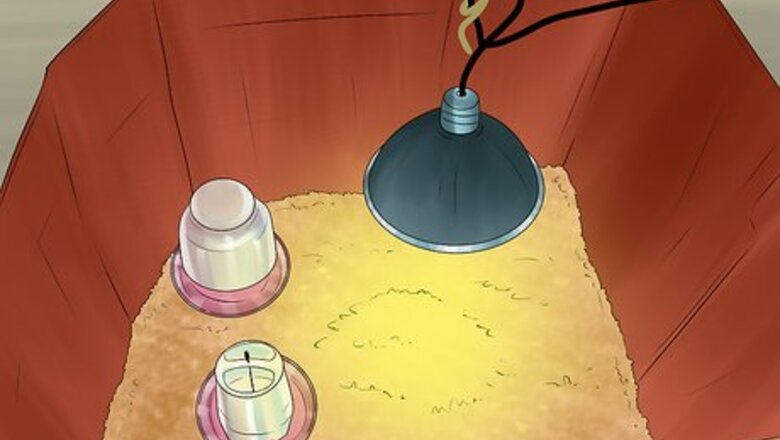
views
Caring for the Baby Quail

Prepare a proper environment for your quail chicks. Baby quail should be kept indoors in a brooder with a heat lamp, hiding hut, and dry bedding until they are 4 to 6 weeks old. The brooder will make a secure environment for your quail chicks to grow. A brooder is a box that will keep the quail safe, clean, and warm. It can be made out of a cardboard box or a plastic tote and should provide one square foot (30 centimeters) of space for each six chicks. After a few weeks, you will need to give the birds a little more room. Four chicks should have at least one square foot (30 centimeters) between them. If the environment isn't safe or comfortable for your chicks, they will not feel secure and taming them will be a lot harder. The quail chicks should be kept at 95 to 97 degrees Fahrenheit (35 to 36 degrees Celsius) during the first week of their lives. The temperature can then be decreased by 5 degrees per week. After about 5 weeks your chicks should be acclimated to a temperature of 75 degrees Fahrenheit (24 degrees Celsius).
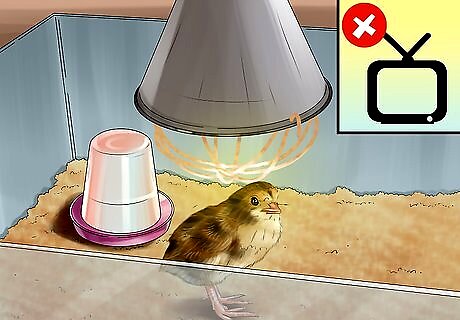
Place the quails in a quiet and safe area. Avoid putting your baby quail in a room with lots of noise and children. Talk in hushed tones and remove anything that creates a racket such as the TV or radio. The calmer the environment, the more relaxed your quail will be. If the bird is calm, it will be easier to tame. Keep pets away from the brooder. Even smaller animals, such as birds, can be seen as a threat to baby quail. Dogs and cats should definitely be kept away out of the same room as they are predators to small quail chicks. Keep your chicks in a room where you are most present. Even if you don't interact with them, your quail chicks will become use to your voice and surroundings. A suitable room may be your bedroom.
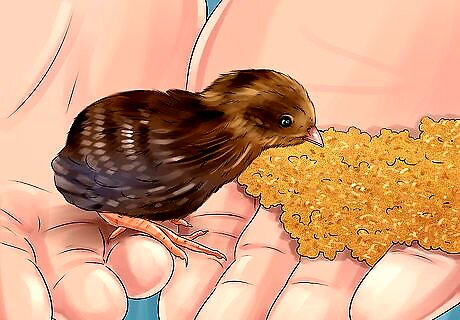
Feed the baby quail. When your quail are very young, you should feed them starter crumb, which is a commercial product made to feed to young poultry. The birds can be given an unlimited supply of this crumb, as they tend not to over eat. You should also give them various greens for them to eat. Pick grass and leafy greens, rinse them, and give them to the birds daily.
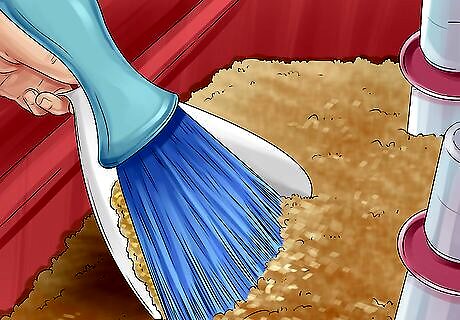
Keep the quail's environment clean. It is important that you keep their home clean to avoid bacterial build up. Change out bedding, which is typically wood shavings, every few days, or whenever the bedding is visibly dirty. Wash the brooder from top to bottom at least weekly. Clean it with warm soapy water and let it dry before you put new bedding and the baby quail back in it.
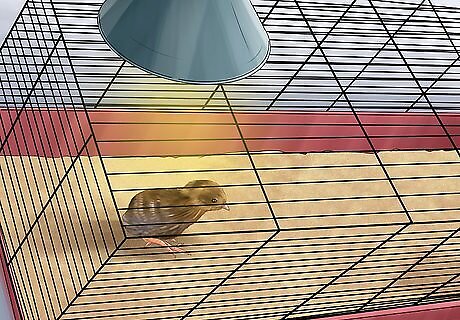
Transition the quail into a cage. Once the quail are 4 to 6 weeks old, they should be able to transition into their permanent cage. Adult quail should be housed in a cage that allows for at least one square foot (30 centimeters) per bird. Quail can be kept indoors or outdoors, although more people choose to keep their birds outside. If you do put your quail outside, make sure their cage is protected from the elements and stays shaded on sunny days.
Building up Trust
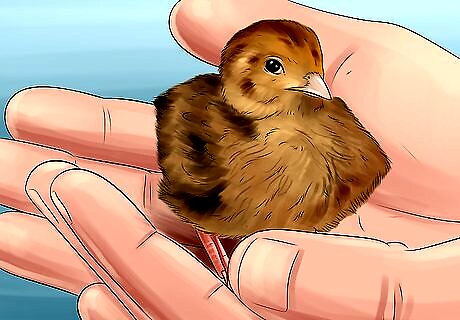
Begin taming your quail as early as possible. You should begin to handle your chicks as soon as they have dried and are mobile after hatching. They will imprint onto you as long as you show them trust and care. The sooner you begin to handle your chicks, the quicker they will learn to trust you.
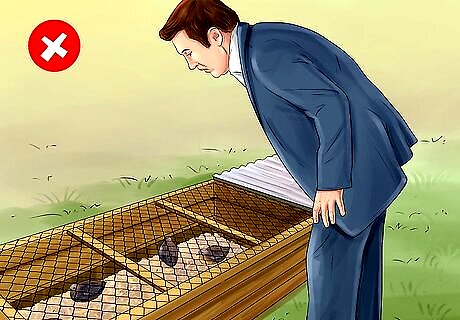
Do not make any threatening movements. Quails are ground-dwelling prey birds, meaning that they are scared of movements from above. Also, loud noises can signal that there is a predator near by. With this in mind, do not stoop above them or reach to grab them in any way from above. They prefer movements at their eye level.
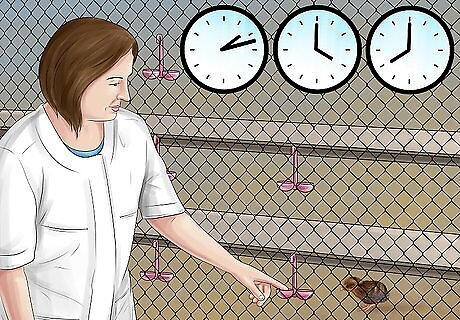
Visit with your quail chicks regularly. If you're going to be taming your quails, it takes time and patience. You should visit them at least once a day but three times a day is ideal. Try to spend at least 30 minutes with your quail on each visit. Find yourself a seat or pillow to sit on and spend some time getting them used to your presence. Stay at the quail's eye-level, instead of leaning over the bird.

Socialize with your quail. Make small talk with your little pets. They will appreciate it. Your quail will need to get used to the sound of your voice so they don't get scared when they hear you talking by their cage. Talk to the quail in a quiet, calm, and soothing tone. Avoid jumpy and loud remarks. Talk or sing each time you are near the brooder. This will help the baby quail recognize who you are before you are visible to them.
Interacting with the Baby Quail
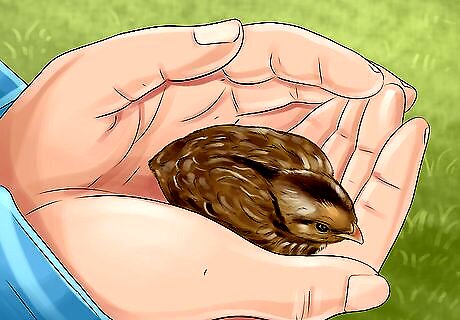
Get them used to your hand. This can be as simple as placing your hand in their brooder on a regular basis. Once your chicks are comfortable with your hand, they will begin to walk beside it or even walk over your hand. This will help prep you for hand-feeding and holding them. Do not move your hand around or try to grab the quail when they get close to it. A sudden or aggressive move will make them scared and will set back the taming timeline because they won't trust you. A good time to get the chicks used to your hand is when you are cleaning out their brooder.

Offer food from your hands. Pull out any food from the brooder and offer the chicks food from your hands. Encouraging your quail chicks to come to you for food is the most effective trick to taming animals. Chick crumbles, a commercial product, work best. They are easy for baby quails to digest. You can additionally use a mash feed or other treats suitable for quail chicks to digest. Do not chase your chicks around with the treats. You should keep your hand still inside of the cage. This won't work if they have food available to them in their cage. Choose a time where your chicks are most hungry. Don't forget to put the chick's food back in the brooder once you are done feeding them by hand. They should have food available at all times.

Set up a regular routine. Quail chicks don't magically become tame over one taming session. Taming is a long process that requires a regular routine to get the baby quail used to you. A schedule will benefit both you and your baby quail chicks in getting used to each other. You should work on taming your chicks at the minimum once a day for a half an hour. However, the more the better! Taming your chicks will likely take several months. Be patient and keep working with your chicks even if you don't think they will ever get used to you.

Allow the baby quail to come to you. The goal of all of this work is to make the chicks trust you and come willingly to your hand. Once they start approaching you, just rub them lightly under their beak and above their belly. Once this becomes habit, they will eventually want to climb into your hand on their own. If you do pick up the chick, slide your hands under it and don't grab it from above. You can make the situation a lot more difficult and scare the little quail if you act like a predator and grab it from above. Remember to always wash your hands before and after handling your quail.


















Comments
0 comment